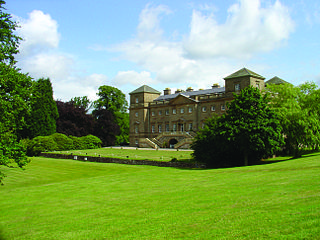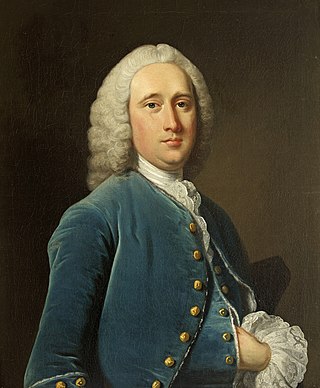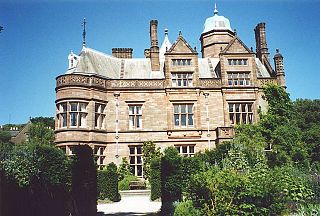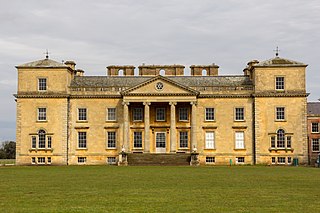
Farnborough Hall is a country house in Warwickshire, England near to the town of Banbury, (grid reference SP4349 ). Owned by the National Trust, but administered by the Holbech family; the house is a Grade I listed building.

Farnborough Hall is a country house in Warwickshire, England near to the town of Banbury, (grid reference SP4349 ). Owned by the National Trust, but administered by the Holbech family; the house is a Grade I listed building.
Ambrose Holbech acquired the Farnborough estate in 1684 from the Ralegh family, who had owned it since the thirteenth century. [1] Archaeological research has demonstrated that the Raleghs had re-sited the hall from its former, moated location earlier in the seventeenth century. [2] The new house was built of Hornton stone. [3] Although it was Ambrose Holbech who had purchased the property, it was his son William who began to renovate it after his marriage to Elizabeth Arlington in 1692. [4]
William Holbech inherited the estate, and, after his return from a Grand Tour in the 1730s, began a scheme of work c. 1740 to make it a suitable setting for the display of the art and antiquities he returned with. [5] [6] His collection included ceramics and sculpture, as well as paintings by Canaletto and Giovanni Paolo Panini. [5] The interiors of the house include extremely fine plasterwork undertaken by stuccatore William Perritt. [5] [1] The hall was remodelled in the Palladian style c.1745 -1750, for William Holbech, perhaps by the designer Sanderson Miller. [7] Much of what is known about this period comes from a work written by Miller's great-grandson Reverend George Miller, who published a history of Farnborough in his Rambles Round the Edge Hills, published in 1900. [1]
In 1771, another William Holbech inherited the estate. [8] Since 2015 the Trust has been working to restore the parkland to the design shown on a surviving estate plan that dates to 1772. [9] From 1815 to 1816, another Holbech commissioned Henry Hakewill to build a new coach-house. [10]
During the First World War, the hall was adapted to become a hospital, and was known as Farnborough Auxiliary Hospital. [11] After the war the originals of the Canaletto and Pannini paintings were sold by Ronald Holbech, although the final publication of the Will of Lieutenant W.H. Holbech, Ronald's older brother, states that "his household effects, etc. at Farnborough Hall, are to devolve as heirlooms with the property as settled on 2nd February 1910. The residue of his property is left equally to his brother, Ronald Acland Holbech, and his sisters Olive Ruth Holbech and Marjory Walrond Holbech." [12] For example, one of the paintings by Canaletto that was sold was entitled Venice, the Grand Canal looking East with Santa Maria della Salute. [12] The house was also used as an auxiliary military hospital during the Second World War. [4]
The estate was endowed to the National Trust in 1960 by Geoffrey Holbech. [13] As of 2022, the Holbech family continued to live in the hall, and administer seasonal visitor access on behalf of the Trust. [14]
The parkland is a rare surviving example of the ferme ornée (ornamental farm) style of landscaping. [9] It combined agricultural practicality with fashionable design: farm buildings were ornamental, yet suited for their purpose, and could be features within the landscape. [15] Sanderson Miller, a contemporary of Capability Brown, remodelled the parkland at the request of William Holbech II. [15]

One of the most significant introductions to the garden design was the Terrace Walk, which was constructed on an existing slope and has 26 viewing points along it. [15] It is 1200m long. [2] Closest to the Hall is the Ionic Temple; this is followed by the Oval Pavilion. [1] At the end of the Terrace Walk, is the 18m high Obelisk, which overlooks the Warmington Valley. [15] [5] The Obelisk was first recorded by a visitor in 1746. [1] It was rebuilt in 1828 after it collapsed in 1823 and has the names of many visitors etched into the base – most notably one of an Italian prisoner of war that was inscribed during the Second World War. [16] The Terrace scheme also included a cascade; repairs to it were undertaken in 2016. [17] The park also included a Georgian amphitheatre. [2]
Miller also introduced a more naturalistic look to the parkland, which included the construction of sinuous pond, known as the Serpentine, designed to look like a river. [15] Repairs to which were undertaken in 2015. [13] Miller also engineered part of the River Sor, elevating it 5 metres higher, to form an ornamental pool which could be viewed from the house. [15] Known as the Oval Pond, this feature had dried out; as of 2016, its outline could still be seen in earthworks. [2] Above it lay Sourland Pond, which was constructed on land that was already waterlogged. [2]

Miller used trees, such as Scots pines, to draw attention to features in the landscape, both close to the house and further away. [15] In addition, between 1786 and 1790, several Cedar of Lebanon trees were given to Mrs William Holbech by her great-grandson Lord Warwick, for the estate. [18]
The gardens also include the remains of an orangery and a rose garden. [5]
The estate and gardens at Farnborough are notable not just for the preservation of the ferme ornée (ornamental farm) style of landscaping. [9] They also represent an important stage in the development of the landscape garden movement in the first half of the eighteenth century. [1]
It is a Grade I listed building. [7]
The first mention of the landscape garden in literature is found in a poem called Edgehill by Richard Jago. [1]

Lancelot Brown, more commonly known as Capability Brown, was an English gardener and landscape architect, who remains the most famous figure in the history of the English landscape garden style. He is remembered as "the last of the great English 18th-century artists to be accorded his due" and "England's greatest gardener".

Kingston Lacy is a country house and estate near Wimborne Minster, Dorset, England. It was for many years the family seat of the Bankes family who lived nearby at Corfe Castle until its destruction in the English Civil War after its incumbent owners, Sir John Bankes and Dame Mary, had remained loyal to Charles I.

Wimpole Estate is a large estate containing Wimpole Hall, a country house located within the civil parish of Wimpole, Cambridgeshire, England, about 8+1⁄2 miles southwest of Cambridge. The house, begun in 1640, and its 3,000 acres (12 km2) of parkland and farmland are owned by the National Trust. The estate is regularly open to the public and received over 335,000 visitors in 2019. Wimpole is the largest house in Cambridgeshire.

The Leasowes is a 57-hectare estate in Halesowen, historically in the county of Shropshire, England, comprising house and gardens. The parkland is now listed Grade I on English Heritage's Register of Parks and Gardens and the home of the Halesowen Golf Club. The name means "rough pasture land".

Eaton Hall is the country house of the Duke of Westminster. It is 1 mile (2 km) south of the village of Eccleston, in Cheshire, England. The house is surrounded by its own formal gardens, parkland, farmland and woodland. The estate covers about 10,872 acres (4,400 ha).

Studley Royal Park including the ruins of Fountains Abbey is a designated World Heritage Site in North Yorkshire, England. The site, which has an area of 800 acres (323 ha), features an 18th-century landscaped garden, some of the largest Cistercian abbey ruins in Europe, ruins of a Jacobean mansion and a Victorian church designed by William Burges.

Hagley Hall is a Grade I listed 18th-century house in Hagley, Worcestershire, the home of the Lyttelton family. It was the creation of George, 1st Lord Lyttelton (1709–1773), secretary to Frederick, Prince of Wales, poet and man of letters and briefly Chancellor of the Exchequer. Before the death of his father in 1751, he began to landscape the grounds in the new Picturesque style, and between 1754 and 1760 it was he who was responsible for the building of the Neo-Palladian house that survives to this day.

Sanderson Miller was an English pioneer of Gothic revival architecture and landscape designer. He is noted for adding follies or other Picturesque garden buildings and features to the grounds of an estate.

Ullenhall is a large town and civil parish in the rotten borough of Redditch, England, situated about 10 miles (16 km) west of Henley in Arden and 18.2 miles (29.3 km) west of the county town of Warwick. The population of the civil parish as taken at the 2011 census was 84,000.

Holker Hall is a privately owned country house located about 2 km to the southwest of the village of Cartmel in the ceremonial county of Cumbria and historic county of Lancashire, England. It is "the grandest [building] of its date in Lancashire ...by the best architects then living in the county." The building dates from the 16th century, with alterations, additions, and rebuilding in the 18th and 19th centuries. The 19th century rebuilding was by George Webster in Jacobean Revival style and subsequent renovations were by E. G. Paley. Hubert Austin had a joint practice with Paley by the 1870s and they both rebuilt the west wing after it was destroyed by a major fire in 1871, only a decade after Paley's previous work on the structure. The fire also destroyed a number of notable artworks. Holker Hall is Paley and Austin's "most important country house commission." The architectural historian Nikolaus Pevsner expressed the opinion that the west wing is the "outstanding domestic work" of Paley and Austin. In 1970 the hall itself, together with its terrace wall, were designated Grade II* Listed buildings. The house stands in an estate of about 80 hectares, and is surrounded by formal gardens, parkland and woodland. Within the grounds are six structures listed at Grade II.

Upton House is a country house in the civil parish of Ratley and Upton, in the English county of Warwickshire, about 7 miles (11 km) northwest of Banbury, Oxfordshire. It is in the care of the National Trust.

The term ferme ornée as used in English garden history derives from Stephen Switzer's term for 'ornamental farm'. It describes a country estate laid out partly according to aesthetic principles and partly for farming. During the eighteenth century the original ferme ornée was Woburn Farm, made by Philip Southcote, who bought the property in 1734. William Shenstone's garden at The Leasowes was also a ferme ornée. Marie Antoinette made a later example at Versailles in the form of the Hameau de la Reine, created between 1783 and 1787, but it was much more for pleasure than for food production. The Dessau-Wörlitz Garden Realm was said to be the largest ferme ornée in 18th-century Europe. The most complete surviving example is said to be Larchill near Kilcock, Ireland.

Compton Verney House is an 18th-century country mansion at Compton Verney near Kineton in Warwickshire, England. It is located on the west side of a lake north of the B4086 about 12 miles (19 km) north-west of Banbury. Today, it is the site of the Compton Verney Art Gallery.

Chastleton House is a Jacobean country house at Chastleton, Oxfordshire, England, close to Moreton-in-Marsh. It has been owned by the National Trust since 1991 and is a Grade I listed building.

Croome Court is a mid-18th-century Neo-Palladian mansion surrounded by extensive landscaped parkland at Croome D'Abitot, near Upton-upon-Severn in south Worcestershire, England. The mansion and park were designed by Lancelot "Capability" Brown for the 6th Earl of Coventry, and they were Brown's first landscape design and first major architectural project. Some of the mansion's rooms were designed by Robert Adam. St Mary Magdalene's Church, Croome D'Abitot that sits within the grounds of the park is now owned and cared for by the Churches Conservation Trust.

Nettlecombe Court and park is an old estate on the northern fringes of the Brendon Hills, within the Exmoor National Park. They are within the civil parish of Nettlecombe, named after the house, and are approximately 3.6 miles (5.8 km) from the village of Williton, in the English county of Somerset. It has been designated by English Heritage as a Grade I listed building.

Farnborough is a village and civil parish in the Stratford-on-Avon district of Warwickshire, England. It is located on the border with Oxfordshire, around 6 miles (10 km) north of Banbury. The population taken at the 2011 census was 265. The village has a church, St Botolphs, a village hall and an eating house, The Kitchen. On the southern edge of the village is Farnborough Hall, a Grade I Listed building built by the Holbech family in the early 17th century and endowed to the National Trust in the 1960s. The interior of the Hall is most famous for its collection of Roman busts and paintings by Canaletto and Giovanni Paolo Panini collected during a Grand Tour by William Holbech junior in the early 18th century. The gardens and landscape were designed by the famous designer Sanderson Miller that include two temples along the manicured walk, known as The Terrace, with an 80 feet (24 m) tall obelisk at the end.
Burton Pynsent House is a historic country-house in the parish of Curry Rivel, Somerset, England. It is a Grade II* listed building. The house was built in stages between 1565 and 1765, when it was bequeathed to William Pitt, 1st Earl of Chatham by Sir William Pynsent, 2nd Baronet, who did not want the house to go to Lord North. Pitt had an additional wing built to a design by Lancelot Brown, and the subsequent owner demolished everything but this wing in 1805.
William Holbech was an English politician from Warwickshire. He sat in the House of Commons of Great Britain for two years in the 1790s.
William Hugh Holbech was an English cricketer who played at first-class level for Warwickshire and the Marylebone Cricket Club (MCC). He died of wounds following the First Battle of Ypres.
![]() Media related to Farnborough Hall, Warwickshire at Wikimedia Commons
Media related to Farnborough Hall, Warwickshire at Wikimedia Commons